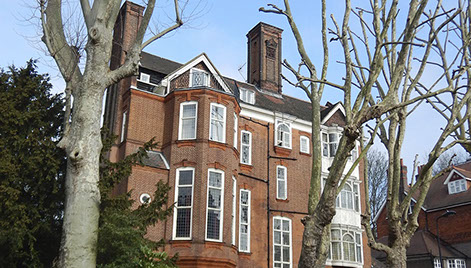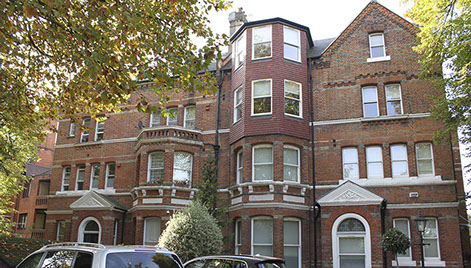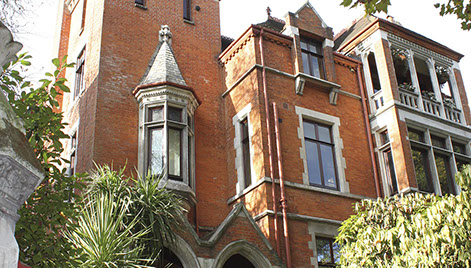Visualisation of the development at 39 Fitzjohn’s Avenue/46 Maresfield Gardens, showing thoughtful articulation of buildings to allow dual aspects.

Housing
Fitzjohn's Avenue
Fitzjohn's Avenue
London
Foreword
A development of 82 new high-specification apartments on “the noblest street in the world” in Hampstead. The proposal respects the Conservation Area’s striking 19th Century vernacular while introducing exciting contemporary architecture.
This proposal would achieve 82 new high-quality, dual-aspect homes in a desirable residential area of London, simultaneously improving the local urban grain and the architectural merit of the 0.7ha site at 39 Fitzjohn’s Avenue/46 Maresfield Gardens.
Situated at the southern end of Fitzjohn’s Avenue, which runs down from Hampstead village to Swiss Cottage, No. 39 is a large, handsome 19th Century house set in extensive grounds planted with mature trees and including a modest and unremarkable detached dwelling (46 Maresfield Gardens).
Our proposal demolishes No. 46 and three unsympathetic extensions made to No. 39 in the 1930s, 50s and 80s. It replaces these with a group of thoughtfully articulated, well-massed apartment blocks with large private balconies from which to enjoy the communal garden and its preserved trees. No. 39 would be sensitively converted into 12 new flats. The apartment mix is informed by Camden Planning Policies, and each flat meets London Housing Design Guide standards.
Heritage and conservation



Queen Anne revival architect Richard Norman Shaw designed several homes on and near Fitzjohn’s Avenue, including 6 Ellerdale Road - a building people would look to for inspiration when designing villas in the area
Each building expresses its scale in a variety of ways, here through cornice lines, bay windows and entrance porch
Exuberant architectural features found along Fitzjohn’s Avenue give each house an independent presence
<
>
Mainly constructed from 1876-1888, the Fitzjohn’s Netherhall Conservation Area features a variety of Victorian architectural styles, including Gothic, Italianate, Tudor revival, Arts and Crafts and Queen Anne-revival. An array of architectural detailing and flourishes includes turrets, tourelles, oriel windows and decorative moulding, resulting in complex buildings with powerful design features. Camden’s Conservation Area Statement asserts that No. 39, which follows the Queen Anne revival style, makes a “positive contribution” to the area, which our proposal respects and celebrates. As described in our exemplary Pre-application Summary Report, the proposed development offers contemporary architecture that is sympathetic to the existing house, and equally worthwhile.
The streetscape is another important aspect of the area, with tightly-packed detached buildings set out in regular, rectangular blocks along wide roads. Our proposed development addresses the current gap in the urban grain at the corner of Maresfield Gardens and Nutley Terrace.
The urban pattern of closely-sited detached houses affords narrow vistas into the back gardens. Our proposal takes a contemporary approach to creating these views, through chamfering the buildings’ form.
Innovation in design and delivery


Model showing the proposed development of 82 new homes, nestled among the existing mature trees.
View onto the corner of the site from the Nutley Terrace and Maresfield Gardens junction.
<
>
We aim to bring much-needed, purpose-built apartment living to a neighbourhood dominated by large Victorian houses, without compromising the distinctive character of the area. The design achieves this with elevations that reference the large proportions of the surrounding original buildings and their tall windows, while allowing a shorter, present-day floor-to-ceiling height.
Red brick is the predominant building material in Hampstead, as well as the proposed material for this development. Exploring how the red brickwork is articulated in the original buildings would result in an exciting and innovative contemporary interpretation of the ornamentation and grandeur of the surrounding urban villas.
The blocks would sit at four storeys, rising to five at the corner of Nutley Terrace and Maresfield Gardens, giving the proposed new buildings a similar height to surrounding villas. The design will continue to evolve, expressing contemporary architectural values but taking note of both the original and newly-appearing architecture in the surrounding area.
Related
SUBSCRIBE
Click below to subscribe to our newsletter or to manage your preferences
Subscribe to our newsletter
© 2020 Lyndon Goode Architects Ltd






